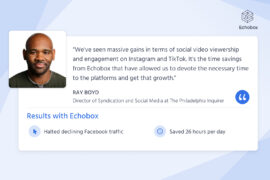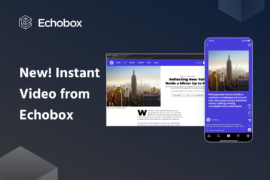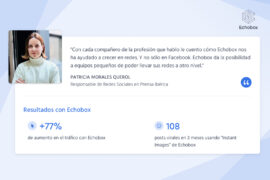In April, Elon Musk’s Twitter introduced new paid tiers for developers, which demand a fee for sharing content onto Twitter. This is unusual, as social networks (such as Facebook, Twitter, Instagram, LinkedIn etc) have always been free to share to as they benefit from quality content on their platform. The more content there is to peruse on a social network, the more their users are engaged. And the higher the engagement, the more advertising gets displayed and – most importantly – the more data on user interests can be collected by the social network, which is then used to yield higher CPMs.
We at Echobox were therefore a bit puzzled as to Twitter’s new tiers. We were even more puzzled by Twitter’s sudden, unannounced suspensions of countless software companies when they introduced their new tiers.
Although we, along with other companies, have now obtained a pricing proposal from Twitter for the “enterprise tier”, it’s become clear that their fees simply aren’t realistic. This is why certain leading software companies are quitting their integrations with Twitter altogether, such as Intercom.
We decided to find a different solution that would allow us to keep offering Twitter to all our customers without having to increase our prices, and in only 3 days, we managed to build a brand new Twitter integration.
Nevertheless, we are entering a new era in how publishers use Twitter. Here are 5 tips to improve your performance on the new Twitter and combat these changes.
| Please note that all software vendors will be affected by Twitter’s new tiers. Even if another social publishing software isn’t affected right now, they will be as Twitter rolls out its new tiers globally. Moreover, businesses on Twitter’s old enterprise tiers (which were 90% cheaper and didn’t impose sharing limits) will also be affected as annual enterprise contracts get renewed.
All companies will eventually be faced with the same predicament. |
1) Change your sharing strategy on Twitter
Although Twitter never generated much traffic for publishers on average (see the Social Media Index), publishers felt it’s important to keep a presence on Twitter. Many of our customers treat Twitter as a newsfeed on which they publish most, if not all their content. But this is now changing. Mr Musk doesn’t want publishers to share “too much” on his new Twitter anymore. This became evident in his statement about the New York Times:
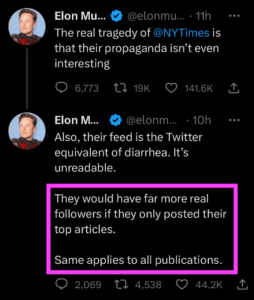
He states that sharing fewer, but the best articles is how he envisages his Twitter going forward. Here’s a video of Mr Musk elaborating further.
Twitter’s introduction of the “For You” tab, which is now the default view for all users on Twitter, has made a publisher’s sharing strategy on Mr Musk’s Twitter more akin to how Facebook has always been. Facebook penalizes publishers that share too much (see our scientific study) and quality over quantity has always been a fitting strategy for Facebook. Twitter is now gunning for the same behavior.
Some of our larger customers have many Twitter pages and have been historically sharing far more than what’s permitted under the “basic tier” of Twitter’s new tier system. We highly recommend not to continue this practice as it goes against Twitter’s guidance. Instead, think of Twitter more like another Facebook: share only your most viral content, with curated share messages and optimized timing.
We ran an internal study to measure the effect of sharing significantly less on Twitter. Here’s an example of a renowned publisher client based in the Americas. As you can see, even though they reduced their sharing to below 50 tweets a day after reconnecting Twitter (green area), their pageviews from Twitter remained the same as when they were tweeting about 160 times a day (red area):
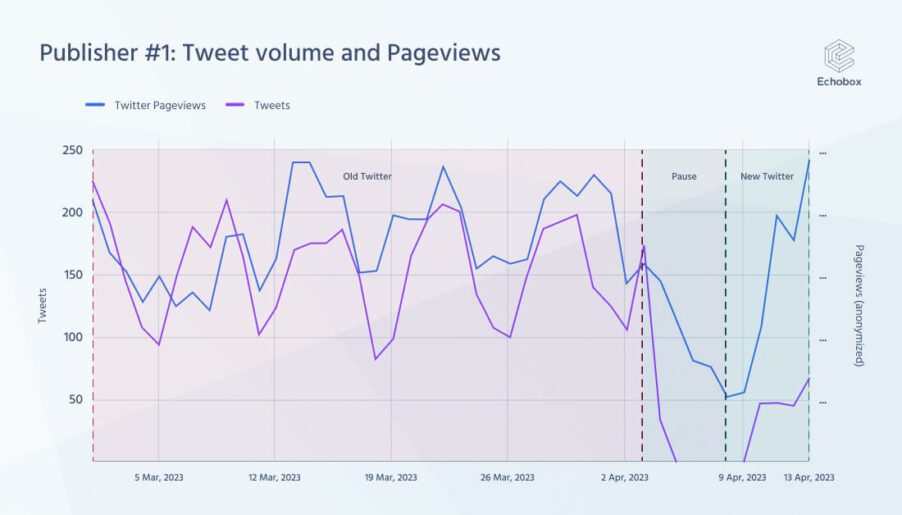
Read the full post for more details
There’s always a risk of traffic falling when sharing too little. We’re still collecting more data to determine the optimal share frequency on Mr Musk’s new Twitter, but the above examples are telling indicators.
For the vast majority of publishers with a single main Twitter page, there’s no need to move to a paid tier on Twitter. Keeping within the share limits of the free tier should be sufficient.
2) Echobox’s virality scores & timing optimisations are now more important than ever
Audiences on Twitter are different from audiences on Facebook. The same content that works on Facebook doesn’t necessarily work on Twitter. The same goes for timing. Your audience segments on Facebook are active at different times of the day than your audiences on Twitter. This is where Echobox’s virality scores and optimal times have become essential, which optimize for each social network independently. Further, they are also tailored to each individual social page and we highly recommend you rely on those when sharing to Twitter. (Don’t delay breaking news though.)
3) Sign up for Twitter Blue to be included in the “For You” feed
We recommend obtaining the Twitter Blue subscription to give you a verified badge, as only tweets from verified accounts will appear in the “For You” feed. Given the “For You” feed is now the default user view on Twitter, it’s crucial you obtain that badge so your content can be seen by your followers.
4) Keep sharing on Twitter, but diversify
Keep sharing on Twitter as there’s still a substantial audience on the platform. However, it’s crucial to diversify your social channels as much as possible.
Echobox offers integrations for Facebook, Instagram, TikTok, LinkedIn and Twitter, allowing you to optimize your posting on each platform separately, and easily manage your workflow across these networks.
5) Reduce your dependence on social platforms
And finally, most publishers we’ve spoken to in the last 12 months have said that they want to reduce their dependence on social platforms altogether by growing owned audiences. One way is to create a strong email newsletter channel. This is why we developed Echobox Email.
Everyone who’s seen Echobox Email has told us it’s one of the most impressive and innovative workflows they’ve ever seen, and we’re proud of that. Our email solution was built from the ground up specifically for publishers. It’s very different from any existing email solution and will help you convert your anonymous social followers to email addresses that you can distribute your content to – without being subjected to the erratic whims of Mr Musk’s or Mr Zuckerberg’s algorithms.
We’re strong believers in a vibrant, free independent press. At Echobox, we’re devoted to helping publishers thrive in a turbulent world and we’d love to hear back from you with any feedback or questions you may have. If you’re an Echobox customer you can reach out to your Customer Success rep. Otherwise you can find us at Facebook, LinkedIn and, of course, Twitter.
